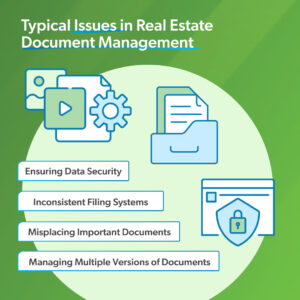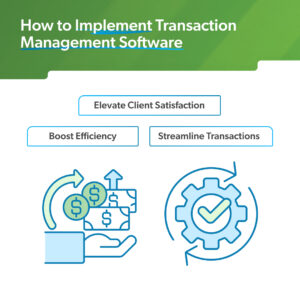
Efficiently managing real estate documents is essential for keeping your business organized and your transactions running smoothly. With the volume of paperwork involved—contracts, lease agreements, disclosures, and more—it’s easy for things to get overwhelming. However, with the right strategies and tools, you can streamline document management, reduce errors, and save valuable time. In this article, we’ll explore practical tips and best practices to help you handle your real estate documents more effectively, ensuring that you stay on top of your game and provide exceptional service to your clients.
Why Document Management is Essential
Effective document management is crucial for real estate success because it ensures that all important records, contracts, and agreements are organized, accessible, and secure. With so many documents involved in each transaction, a streamlined system helps prevent errors, reduces the risk of lost or misplaced files, and ensures compliance with legal and regulatory requirements. By managing documents efficiently, real estate professionals can save time, improve client satisfaction, and maintain a smooth workflow, ultimately driving business growth.
Typical Issues in Real Estate Document Management
Managing real estate documents presents several common challenges, such as handling large volumes of paperwork and maintaining both physical and digital files. Ensuring data security, preventing the misplacement of important documents, and dealing with inconsistent filing systems can lead to errors and delays. Additionally, managing multiple versions of contracts and staying compliant with regulations are ongoing struggles. These challenges can make it difficult to maintain efficiency and can negatively impact overall business operations.
Handling Large Volumes of Paperwork
Dealing with large volumes of paperwork is a significant challenge in real estate document management. The sheer number of contracts, agreements, and legal documents can lead to disorganization, misfiling, and processing delays. Without an efficient system, managing this paperwork can become overwhelming, resulting in errors and lost time.
Managing Both Physical and Digital Files
Balancing the management of both physical and digital files is a common issue in real estate. Physical documents can be easily misplaced or damaged, while digital files may suffer from inconsistent organization. The lack of a unified system for managing both types can lead to inefficiencies, making it difficult to retrieve necessary documents quickly.
Ensuring Data Security and Confidentiality
Ensuring data security and confidentiality is critical in real estate, where sensitive client information is handled regularly. Poor document management practices can expose confidential information to unauthorized access, leading to potential breaches. Implementing robust security measures and consistent handling procedures is essential to protect client data and maintain trust in your business.
Maintaining Compliance with Legal Requirements
Maintaining compliance with legal requirements is a significant challenge in real estate document management. Laws and regulations dictate how documents should be handled, stored, and accessed. Failure to comply can result in fines, legal disputes, and damage to your reputation.
Organizing Documents for Easy Retrieval
With numerous files to manage, a poorly structured system can lead to time-consuming searches and misplaced documents. Implementing a consistent filing system and utilizing document management tools can help ensure that important documents are readily accessible when needed.
Overcoming the Challenges of Document Sharing and Collaboration
Document sharing and collaboration present challenges, especially when multiple parties are involved. Issues can arise from version control, access restrictions, and ensuring everyone has the latest information. Without a centralized system, these challenges can lead to confusion and delays. Effective collaboration tools and clear protocols are essential for smooth document sharing during real estate transactions.
How Transaction Management Systems Can Solve Document Management Challenges
Transaction management tools for real estate offer powerful solutions to the common challenges of document management in real estate. By centralizing all documents in one secure platform, these systems streamline the organization, retrieval, and sharing of important files. They automate tasks like version control, compliance tracking, and secure storage, reducing the risk of errors and ensuring that all documents are easily accessible. Additionally, transaction management systems enhance collaboration among team members and clients, making the entire process more efficient and less prone to mistakes.
Centralizing All Documents in One Secure Platform
Real estate transaction management systems centralize all documents in one secure platform, making it easier to manage and access essential files. This centralized approach reduces the risk of lost or misplaced documents, ensures consistency, and provides a secure environment where all team members can find the information they need quickly and efficiently.
Automating Document Storage and Retrieval Processes
Automating document storage and retrieval processes with a transaction management system simplifies organization and reduces the time spent searching for files. Automated systems categorize and store documents systematically, allowing for quick retrieval and minimizing the risk of human error, which enhances overall productivity and accuracy.
Reducing Errors with Version Control and Audit Trails
Transaction management systems help reduce errors by implementing version control and audit trails. Version control ensures that all users are working with the most up-to-date documents, preventing mistakes due to outdated information. Audit trails provide a detailed history of document changes, ensuring transparency and accountability throughout the real estate transaction process.
Streamlining the Signing Process with Digital Signatures
Digital signatures streamline the signing process by allowing clients to sign documents electronically through a transaction management platform. This approach eliminates the need for in-person meetings, speeds up transaction timelines, and ensures that all signatures are securely captured. The result is a more efficient, convenient process that benefits both clients and real estate professionals.
Enhancing Collaboration Through Real-Time Document Sharing
Real estate transaction management systems enhance collaboration by enabling real-time document sharing among team members and clients. This feature ensures that everyone has access to the latest information, streamlining communication and reducing delays. By facilitating instant updates and edits, these systems promote more efficient teamwork and smoother transactions.
Improving Client Communication with Digital Access
Digital access enhances client communication by allowing clients to securely view, sign, and download important documents at their convenience. This transparency keeps clients informed throughout the transaction process, fostering trust and satisfaction. With everything easily accessible in one place, clients enjoy a more streamlined and user-friendly experience, leading to stronger relationships.
Ensuring Data Security with Advanced Encryption and Access Controls
Advanced encryption and access controls play a crucial role in ensuring data security. Sensitive documents are shielded from unauthorized access, minimizing the risk of breaches. By using a real estate transaction management platform to provide precise control over who can view and edit specific documents, these security measures help protect client information and ensure compliance with industry regulations.
Streamlining Workflow with Customizable Transaction Templates
Customizable transaction templates simplify workflows by providing standardized forms and contracts tailored to your needs. These templates save time by reducing the effort needed to create transactions from scratch, ensuring consistency and accuracy across all transactions. By using these templates, you can remain a professional appearance while minimizing the risk of errors.
Key Features to Look for in a Transaction Management System
When choosing a document management system for your real estate business, it’s essential to consider key features that enhance efficiency and security. Look for a system that offers user-friendly navigation, robust search capabilities, and secure storage with encryption. Integration with existing tools, version control, and real-time collaboration are also important. A system with customizable templates and compliance tracking can further streamline operations, making it easier to manage documents and stay organized in a fast-paced industry.
User-Friendly Interface and Navigation
A user-friendly interface and intuitive navigation are crucial when choosing a document management system. These features ensure that all team members, regardless of technical expertise, can quickly access and manage documents. A simple, well-organized layout enhances productivity by reducing the time spent searching for files and learning the system.
Mobile Access for On-the-Go Document Management
Mobile access is essential for real estate professionals who need to manage documents on the go. A document management system with mobile capabilities allows you to access, edit, and share files from any device, ensuring you stay productive and responsive, even when away from the office.
Real-Time Collaboration and Document Sharing
Real-time collaboration and document sharing are key features in a document management system. These capabilities enable multiple users to work on the same document simultaneously, ensuring everyone has the most up-to-date information. This enhances teamwork, reduces miscommunication, and speeds up the transaction process, leading to quicker closings.
Compliance Management and Regulatory Support
Compliance management and regulatory support are critical features in a document management system. These tools help ensure that all documents adhere to industry regulations and legal requirements, reducing the risk of non-compliance. Automatic updates and built-in compliance checks provide peace of mind, keeping your real estate business on the right track.
Live Tech Support
While many companies rely on chatbots or email support, some provide live tech support with extended hours. For example, Form Simplicity’s real estate transaction management platform offers a dedicated team available in real-time, ensuring prompt, personalized assistance whenever you need it. This level of support helps resolve issues quickly and enhances the overall user experience.
Integration with Existing Real Estate Software
Integration with existing real estate software is crucial when selecting a document management system. Seamless compatibility with tools like CRM systems, cloud storage platforms, and digital payment platforms ensures that all your business processes are connected and streamlined. This integration enhances efficiency and reduces the need for manual data entry, allowing for a more cohesive and productive workflow.
How to Implement Transaction Management Software
Implementing transaction management software can be a straightforward and rewarding process with the right approach. With careful planning and execution, you’ll be able to streamline your transactions, boost efficiency, and elevate client satisfaction.
We’re here to help make the transition smooth and successful. In the following sections, you’ll find practical tips and guidance to ensure you get the most out of your new transaction management software.
 Transferring Existing Documents and Information
Transferring Existing Documents and Information
When transitioning to a new software, transferring your existing documents and information is crucial. Ensure that all your files, records, and data are smoothly migrated into the new system to maintain continuity. Properly transferring this information allows your team to pick up where they left off, minimizing disruptions and ensuring a seamless integration into your daily operations.
Customizing the Software to Fit Your Workflow
Customizing the software to align with your specific workflow is essential for maximizing its effectiveness. Adjust settings, templates, and features to match your business processes, ensuring that the software supports your team’s daily tasks. Tailoring the system to your needs enhances efficiency and helps you get the most out of the tool.
Training Your Team for a Smooth Transition
Getting your team up to speed with the new software is key to a smooth transition. Offer friendly, thorough training sessions that cover all the ins and outs of the system, making sure everyone feels confident using it. With ongoing support and resources, your team will adapt quickly, keeping everything running smoothly without missing a beat.
Integrating the Software with Existing Tools and Systems
To keep everything running smoothly, it’s important to integrate the transaction management software with the tools and systems you already use. Make sure it works well with your CRM, accounting software, and other key applications. By doing this, you’ll reduce manual data entry, boost efficiency, and create a more streamlined workflow for your team.
Testing the System Before Full Deployment
Before you officially launch the transaction management software, it’s a good idea to give it a thorough test. This lets you catch any issues early and make sure everything is working perfectly with your existing processes. Testing helps prevent surprises and ensures a smooth, successful rollout when you’re ready to go live.
Schedule a Demo of Our Real Estate Transaction Management Platform
Scheduling a demo of our real estate transaction management platform is the first step toward transforming how you manage your transactions. During the demo, you’ll experience firsthand how our platform streamlines document management, automates compliance tracking, and enhances communication, all within a user-friendly interface. Our experts will guide you through the platform’s features, showing you how it can save time, reduce errors, and improve overall efficiency.
Whether you’re looking to simplify complex transactions or boost client satisfaction, our platform offers the tools you need. Demos are available for brokers and association executives onboarding 10 or more agents, while individual agents and smaller brokerages can attend live webinars. Don’t miss this opportunity to see how our solution can elevate your real estate operations— schedule your demo today!




